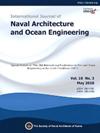从2D螺旋桨图纸中自动提取和恢复设计参数
IF 3.9
3区 工程技术
Q2 ENGINEERING, MARINE
International Journal of Naval Architecture and Ocean Engineering
Pub Date : 2025-01-01
DOI:10.1016/j.ijnaoe.2025.100689
引用次数: 0
摘要
造船业越来越需要2D图纸中的3D螺旋桨模型,用于维修、改造和节能装置(ESD)分析。但出于安全考虑,客户通常只提供2D图纸,手动提取螺旋桨模型信息耗时费力,且容易出错。这凸显了对自动化、精确提取技术的需求。本文提出了一种从螺旋桨二维图纸中获取设计参数的直线检测和信息提取方法。该方法将PDF图纸转换为图像,对其进行预处理,然后使用寻路算法检测线条并提取信息。这些提取的数据通过偏移数据采集转换为设计参数,如前倾角、斜度、弦长、弧度和厚度。将该方法应用于螺旋桨图纸,与手工工作相比,大大减少了时间和精力,大大提高了效率和恢复精度。该方法有效地检测了复杂和重叠的线条,并验证了提取的设计参数的定量准确性,大多数参数的误差小于1%。本文章由计算机程序翻译,如有差异,请以英文原文为准。
Automated design parameter extraction and restoration from 2D propeller drawings
The shipbuilding industry increasingly needs 3D propeller models from 2D drawings for repair, retrofitting, and energy-saving device (ESD) analysis. However, clients often provide only 2D drawings due to security, making manual information extraction for propeller models time-consuming, labor-intensive, and prone to errors. This highlights the need for automated, accurate extraction techniques. This study proposes a line detection and information extraction method to obtain design parameters from 2D propeller drawings. The method converts PDF drawings to images, preprocesses them, and then uses a path-finding algorithm to detect lines and extract information. This extracted data is converted into design parameters like rake, skew, chord length, camber, and thickness through offset data acquisition. Applying this method to propeller drawings significantly reduces time and effort compared to manual work, greatly improving efficiency and restoration accuracy. The method effectively detects complex and overlapping lines, and the quantitative accuracy of the extracted design parameters has been validated, with most parameters showing less than 1 % error.
求助全文
通过发布文献求助,成功后即可免费获取论文全文。
去求助
来源期刊

International Journal of Naval Architecture and Ocean Engineering
ENGINEERING, MARINE-
CiteScore
4.90
自引率
4.50%
发文量
62
审稿时长
12 months
期刊介绍:
International Journal of Naval Architecture and Ocean Engineering provides a forum for engineers and scientists from a wide range of disciplines to present and discuss various phenomena in the utilization and preservation of ocean environment. Without being limited by the traditional categorization, it is encouraged to present advanced technology development and scientific research, as long as they are aimed for more and better human engagement with ocean environment. Topics include, but not limited to: marine hydrodynamics; structural mechanics; marine propulsion system; design methodology & practice; production technology; system dynamics & control; marine equipment technology; materials science; underwater acoustics; ocean remote sensing; and information technology related to ship and marine systems; ocean energy systems; marine environmental engineering; maritime safety engineering; polar & arctic engineering; coastal & port engineering; subsea engineering; and specialized watercraft engineering.
 求助内容:
求助内容: 应助结果提醒方式:
应助结果提醒方式:


